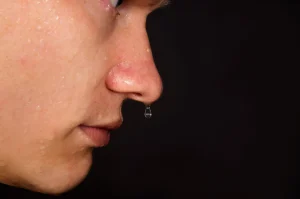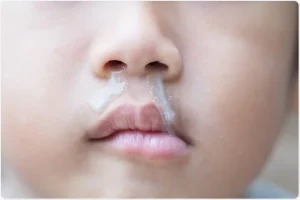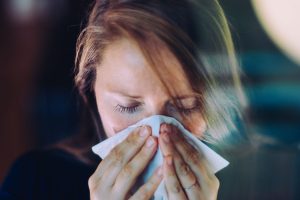
RHINORRHEA
Rhinorrhea. Runny nose, or rhinorrhea, is a relatively frequent symptom. Allergies and viral infections (such as the flu or a cold) are the most common causes. However, your nose may flow due to a number of other illnesses. Although a runny nose usually goes away on its own, some treatments can make it better. Snot, or mucus, “flowing” or pouring from your nose is known as rhinorrhea.
RHINORRHEA
However, There are a number of potential causes, including the common cold, allergies, and cold or dry air. Rhinitis is a similar condition. Your nasal tissues get inflamed when you have rhinitis. The mucus that emerges from your nose might differ in color and consistency. A more watery nasal discharge is usually caused by allergies, spicy foods, and cold weather.
Symptoms

Although, rhinorrhea can arise by itself, the following symptoms are frequently present as well: congestion of the nose, Nasal congestion (stuffy nose). Sneezing. leak after the nose. This occurs when an abnormally high amount of mucus collects and runs down the back of your throat. It may result in coughing and sore throats. eyes that are runny or itchy. Some people may have chronic rhinorrhea, however most occurrences of runny nose are transient.
Causes

Meanwhile, viral illnesses, such as COVID-19, the flu, and the common cold. Most people are not affected by allergens. Your immune system, however, believes the allergen is entering if you have allergic rhinitis. Histamine is released by your immune system in an attempt to defend your body. In an attempt to expel the allergen, it produces inflammation and itching of the mucous membranes in your throat, eyes, and nose. A runny nose is another effect of histamine. Usually, allergies result in more watery nasal discharge. Inhaling a virus causes irritation to the sinus lining and nasal lining (air-filled pockets surrounding your face). In response, your nose begins to produce a large amount of clear mucus. The virus is captured by this mucus, which aids in its removal from your sinuses and nose. You become ill if the virus penetrates your mucous membrane. More mucus is produced by your body, and it may turn white or yellow. Mucus can occasionally take on a greenish hue.
Other causes
Also, cold weather: The air you take in via your nose warms and becomes more humid as it passes into your lungs. Your nasal lining becomes irritated by cold, dry air. A runny nose is the result of your nasal glands producing too much mucus as a defense to keep the lining moist. Tear shedding (lacrimation): The nasolacrimal duct, the inner corner of your eyelids, and your nasal cavities are where your body’s surplus tears go when you cry or have something irritating in your eyes. More nasal discharge may result from these tears dripping out of your nose and stimulating the formation of mucus.
Treatment

Runny noses usually clear up on their own. They usually don’t require medical attention. However, there are several exceptions, such as:
1. Sinus infections
Sinus infections have the potential to resolve spontaneously. However, a doctor can recommend intranasal steroid sprays, oral or topical decongestants, or antibiotics if your symptoms don’t go better after ten days.
2. Chronic rhinitis
In order to identify the underlying reason of your persistent runny nose, your healthcare physician may recommend that you see an ENT expert. Structural issues including enlarged adenoids, a deviated septum, or nasal polyps may require surgery.
3. Nasal foreign bodies
You should remove anything that has become lodged in your child’s or your own nose. Several removal methods are employed by providers, such as suctioning, forced expiration, and tools like tweezers or forceps.
Summary
Also, runny noses can be bothersome, but they are usually transient and indicate that your immune system is functioning properly. Cold weather, colds, the flu, and allergies are major causes of runny noses. Usually, it doesn’t indicate a major illness or infection. To avoid a runny nose or other similar problems, keep in mind to exercise proper cleanliness. If your child’s runny nose seems out of the ordinary, see a doctor.